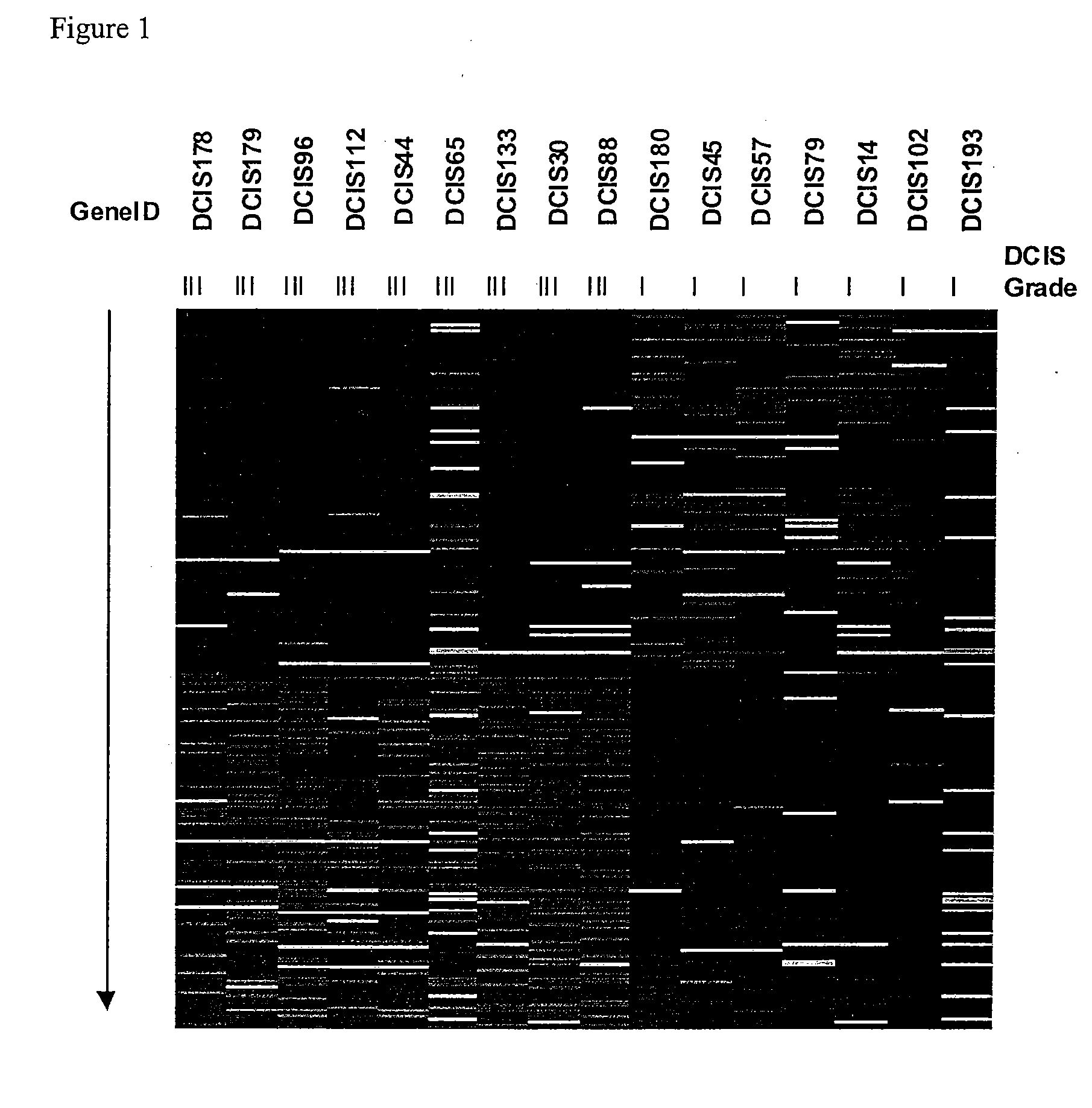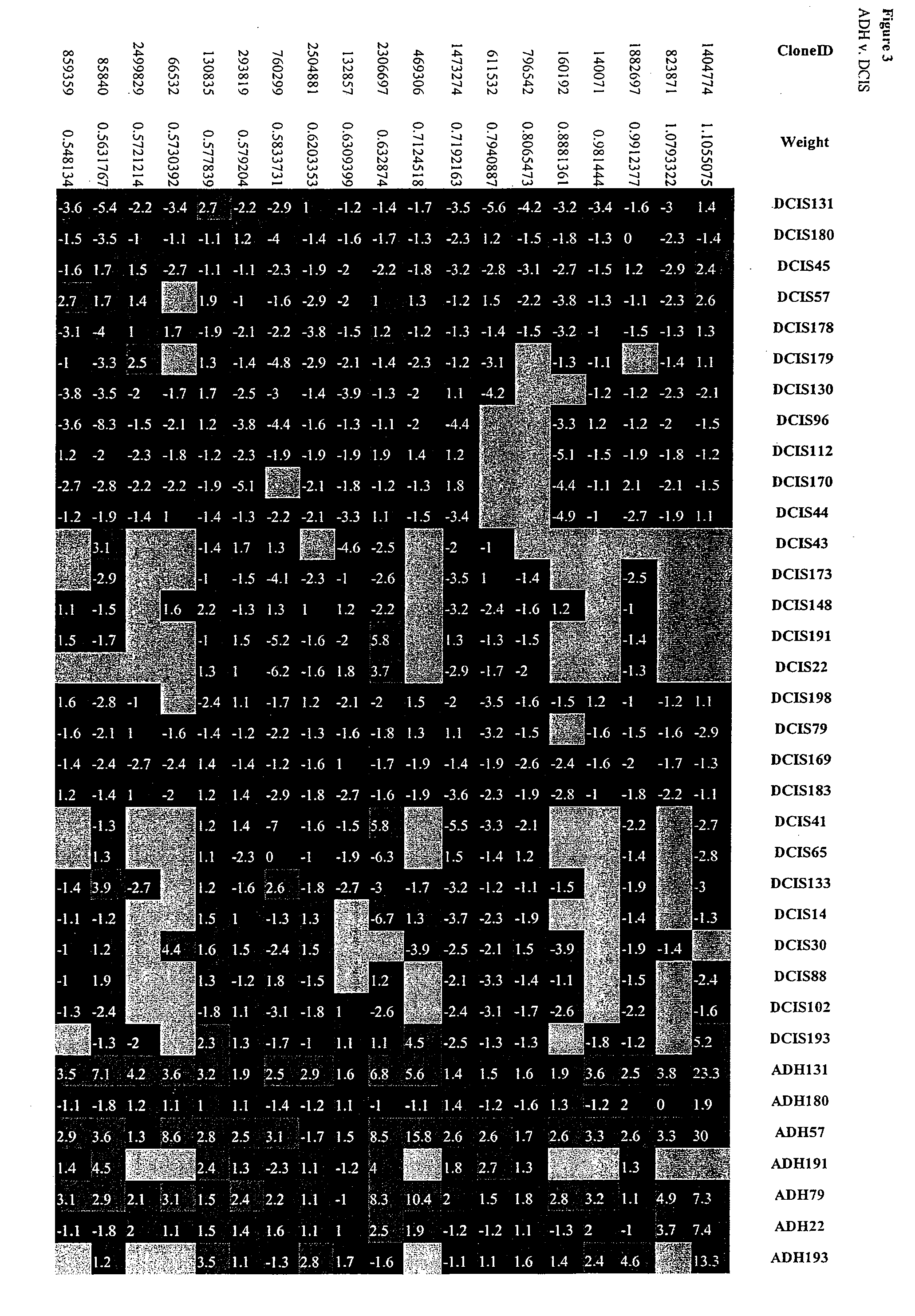Breast cancer progression signatures
a cancer progression and signature technology, applied in the field of identification and use of gene expression profiles, can solve problems such as remaining unpredictabl
- Summary
- Abstract
- Description
- Claims
- Application Information
AI Technical Summary
Benefits of technology
Problems solved by technology
Method used
Image
Examples
specific embodiments
[0048] The present invention relates to the identification and use of gene expression patterns (or profiles or “signatures”) which discriminate between (or are correlated with) cells in various stages of breast cancer. Such patterns may be determined by the methods of the invention by use of a number of reference cell or tissue samples, such as those reviewed by a pathologist of ordinary skill in the pathology of breast cancer, which reflect various stages of breast cancer. Because the overall gene expression profile differs from person to person, cancer to cancer, and cancer cell to cancer cell, correlations between certain cell states and genes expressed or underexpressed may be made as disclosed herein to identify genes that are capable of discriminating between different breast cancer states.
[0049] The present invention may be practiced with any number of genes believed, or likely to be, differentially expressed in breast cancer cells. In Example I below, approximately 12,000 g...
example i
Materials and Methods
Clinical Specimens
[0087] Clinical biopsies from 30 patients were obtained from the Massachusetts General Hospital with Institutional Review Board approval. The tissue from one of the patients was not associated with breast cancer of any kind since it was from a breast reduction procedure. Pathological and histological information for the biopsies were also obtained. Three independent captures of about 1000 breast epithelial cells of one or more of the four different disease stages (normal, N; atypical ductal hyperplasia, ADH; ductal carcinoma in situ, DCIS; invasive ductal carcinoma, IDC) were procured from each biopsy using Laser Capture Microdissection (LCM, Arcturus Engineering). Three independent captures of LCIS (lobular carcinoma in situ) in one biopsy were also made. Total RNA was extracted from the captured (procured) cells and amplified with a T7-promoter based RNA amplification protocol. The human universal reference RNA (Stratagene, La Jolla), was ...
example ii
10 Genes for Discriminating Between ADH and DCIS
[0093] Based upon the methodology of Example I above, 10 genes identified as capable of discriminating between ADH and DCIS are listed in Table 1 below along with a brief description of the gene. CloneID as used in the context of the present invention refers to the IMAGE Consortium clone ID number of each gene, the sequences of which are hereby incorporated by reference in their entireties as they are available from the Consortium at http: / / image.llnl.gov / as accessed on the filing date of the present application. Weight refers to the absolute value indicating the extent of difference in expression between ADH and DCIS where the positively signed values are expressed higher in ADH and the negatively signed values are expressed higher in DCIS; Chromosome Location refers to the human chromosome to which the gene has been assigned, and Description provides a brief identifier of what the gene encodes. The actual data corresponding to the ...
PUM
| Property | Measurement | Unit |
|---|---|---|
| Volume | aaaaa | aaaaa |
| Mass | aaaaa | aaaaa |
| Fraction | aaaaa | aaaaa |
Abstract
Description
Claims
Application Information
 Login to View More
Login to View More - R&D
- Intellectual Property
- Life Sciences
- Materials
- Tech Scout
- Unparalleled Data Quality
- Higher Quality Content
- 60% Fewer Hallucinations
Browse by: Latest US Patents, China's latest patents, Technical Efficacy Thesaurus, Application Domain, Technology Topic, Popular Technical Reports.
© 2025 PatSnap. All rights reserved.Legal|Privacy policy|Modern Slavery Act Transparency Statement|Sitemap|About US| Contact US: help@patsnap.com



